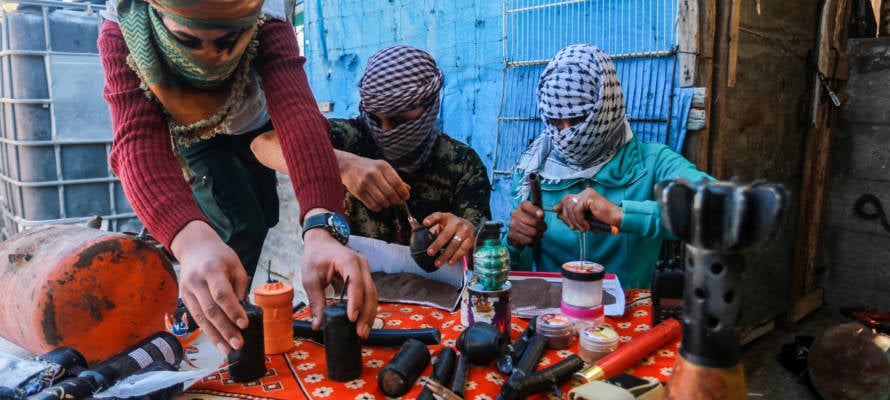Isn’t there a contradiction between the use of violence and political negotiation? Is it possible to engage in both simultaneously?
By Shmuel Sandler, BESA Center
The latest round of violence in Gaza once again raised issues about the ongoing conflict between Israel and the terror organizations there.
How can negotiations be held while both sides are using force and they are not in direct contact with each other? Isn’t there a contradiction between the use of violence and political negotiation? Is it possible to engage in both simultaneously?
An insight from the field of strategic studies can shed light on this paradox. In the current era, the classic distinction between war and diplomacy that characterized the interstate wars of the 19th century and first half of the 20th has been undermined and replaced by the “diplomacy of violence,” a term coined by Thomas Schelling (who in 2005 won a Nobel Prize in economics together with Israel Aumann).
Schelling overturned Clausewitz’s famous dictum that war is “the continuation of politics by other means” by identifying situations in which violence itself constitutes a diplomatic conversation – an exchange of messages through the use of force.
Although Schelling’s studies dealt with the US’s limited wars in Korea and Vietnam, his insight can be applied to other limited/asymmetric conflicts like the one being waged since 2005 between Israel and the terror organizations in Gaza.
What is the political purpose of Israel’s use of force against Hamas?
For the Israeli governments during these years, militarily crushing and uprooting Hamas has not been a political goal because destroying the organization or expelling it from Gaza would lead to one of two undesirable outcomes: either a transfer of rule to the Palestinian Authority (which was ousted from Gaza by Hamas in 2007) and increased international pressure for a Palestinian state on both sides of Israel, or renewed Israeli control over the Gaza population.
Both outcomes go against Israel’s national interest.
After three operations in Gaza in which Israel avoided all-out war, Hamas is undoubtedly aware of the Israeli dilemma. It continues to challenge Jerusalem, though it is keenly aware of its own limitations vis-à-vis Israel’s vastly more powerful army. Because of Hamas’s uncompromising raison d’être – it wants Israel destroyed – it considers itself ideologically obligated to fight on.
A ‘Violent Diplomatic Conversation’
The limited conflict in fact grows considerably in importance to Hamas as it loses legitimacy in Gaza and among many Arab states, notably Egypt and Saudi Arabia, and as the Palestinian Authority cuts off its funds.
Hamas is not capable of eradicating Israel, and eradicating Hamas is not Israel’s political goal. The two sides thus maintain a limited conflict.
Within that framework, the two sides conduct an ongoing “violent diplomatic conversation” with its own set of rules. Hamas conveys messages through riots along the Gaza border and attacks (primarily) on Gaza-belt communities, while Israel tries to lay down red lines for the organization.
Consider, for example, Minister Tzahi Hanegbi’s statement of November 15, 2018, in which he described a Hamas attack as “minor, most of the fire focused on the Gaza belt. Fire on Tel Aviv is a different story.” Despite Prime Minister Benjamin Netanyahu’s disavowal of that distinction, Israel’s response to missile fire on Tel Aviv and the Sharon Plain late last year was indeed much more massive than its responses to fire on the Gaza belt. Hamas got the message and did not expand fire to the center of the country.
In the latest round as well, Hamas has refrained from broadening missile attacks to the heart of Israel, while the IDF did its best to avoid casualties by making use of “roof knocking” before airstrikes on buildings. When Israel escalated its response with the targeted killing of a terror operative (a step it had avoided for years), the two sides understood that the next stage would entail targeted killing of Hamas leaders on one hand and missile attacks on the center of Israel on the other. The conflict ended before such an escalation could occur.
Can this Strategy be Sustained?
Can such “bargaining through the threat of violence” be sustained over time? So far, it has continued for a decade and a half. Since the unilateral disengagement from Gaza in the summer of 2005, the IDF has conducted three large-scale operations in Gaza – Cast Lead (December 2008-January 2009), Pillar of Defense (November 2012), and Protective Edge (July-August 2014) – in addition to smaller rounds of hostilities.
To describe this pattern of violence, the IDF employs terms like “the campaign between the wars” and “mowing the grass.” In the absence of any possibility of either serious political negotiations or a decisive war, the only alternative is the diplomacy of violence.
Prof. Shmuel Sandler is President of Emunah-Efrat College in Jerusalem and a Senior Research Associate at the BESA Center for Strategic Studies at Bar-Ilan University.
MAKE THE LAND OF ISRAEL EVEN MORE BEAUTIFUL!
PLANT YOUR VERY OWN FRUIT TREES IN ISRAEL!
Farmers near the Gaza border lost family, friends and workers. Spring is here, and they desperately need help to replant the farms. Join us in blessing the People and Land of Israel.
“I will ordain My blessing for you…” (Leviticus 25:4)



